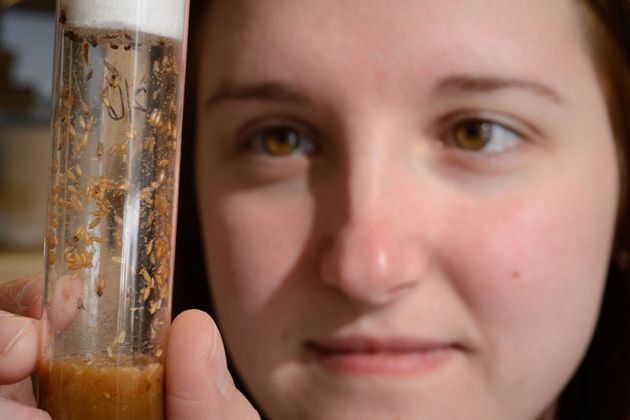Insects are so different from humans that researchers have long assumed that the ovulatory process—how females make eggs—would have nothing in common between our species.
But now researchers at the University of Connecticut report that during that key process, the same gene may govern us both. If correct, the results could bring insight to cancer metastasis, human fertility and ovarian disease.

Jianjun Sun and colleagues in UConn’s department of physiology and neurobiology and their collaborator Allan Spradling at the Carnegie Institution for Science published their findings in this week’s PLOS Genetics.
The differences between female humans and flies are so many and various that, until recently, no one considered whether the way a fly produces an egg could teach us anything about how a woman does it.
We have a general idea of the timing of and the hormones involved in ovulation in humans. The average American woman lives more than 80 years and ovulates for 35 of them, producing an egg approximately once a month.
At the middle of a woman’s menstrual cycle, a surge of hormone induces a mature egg that is wrapped inside a cocoon of cells called the follicle to ripen inside her ovary. When she ovulates, the egg emerges from the follicle and begins traveling to the uterus. Meanwhile, the rest of the follicle transforms into a corpus luteum, a yellowish group of cells that secretes hormones to regulate pregnancy and ovarian function.
What we don’t understand are the precise mechanics regulating these events. How, exactly, does the egg get out of the follicle? What genes govern the process, and what do they do?
Researchers had tried to study the genetic mechanics of ovulation in mice, but mice often have multiple, related genes in their genome that can compensate for each other, so the process often still works even if a single gene is removed.
Fruit flies, however, have a less-redundant genome and a faster life cycle than mice, making them much easier to work with. The typical fruit fly lives about 4 weeks as an adult and ovulates every 30 minutes.

In PLOS Genetics, the researchers report two critical parts of ovulation that seem to be the same in both flies and humans.
The first has to do with the fate of the follicle cells after the egg escapes. Sun’s team found that just as in mammals, in flies the follicle cells blocking the path of the egg out of the ovary degrade and slough off at ovulation. And, just as in mammals, the follicle cells left behind inside the ovary turn into a fly version of the corpus luteum—a group of cells that produces steroid hormones essential for fertility. Fly corpus luteum even develops the same yellowish color as it does in human and mice.
The second has to do with Matrix metalloproteinase (mmp), an enzyme that researchers suspect mammals need to break down the cellular matrix of the follicle in order for the egg to escape. Flies have just two: mmp1 and mmp2. Sun and his colleagues found that knocking out one of those reduced the enzyme levels in a fly’s ovaries, and dramatically reduced the number of eggs laid.
This work provides the first genetic evidence that mmp is required for ovulation and that its role is likely conserved between flies and mice. And, these similarities suggest that the basics of ovulation are very similar in animals generally.
The findings provide a foundation for other researchers to find out exactly which genes are required for ovulation in flies, and so for mice, and so for humans.
“The evolutionary distance between flies and mice is so huge, compared to the distance between mouse and human. Everything that is conserved between fly and mouse is likely be conserved in humans,” Sun says.
The research could prove immediately applicable to fertility disorders in humans such as polycystic ovary syndrome (PCOS), in which women don’t ovulate. Sun’s group is utilizing its fly system to look at PCOS now.
But their findings could also prove useful to understanding the way cancer spreads through the body. When cancers metastasize, individual cells escape from the tumor mass and spread into the bloodstream. How exactly cancer cells escape from their original cell matrix may have something to do with the mmp enzyme, Sun says, and that means this research could eventually inform treatments that block a cancer’s spread.



